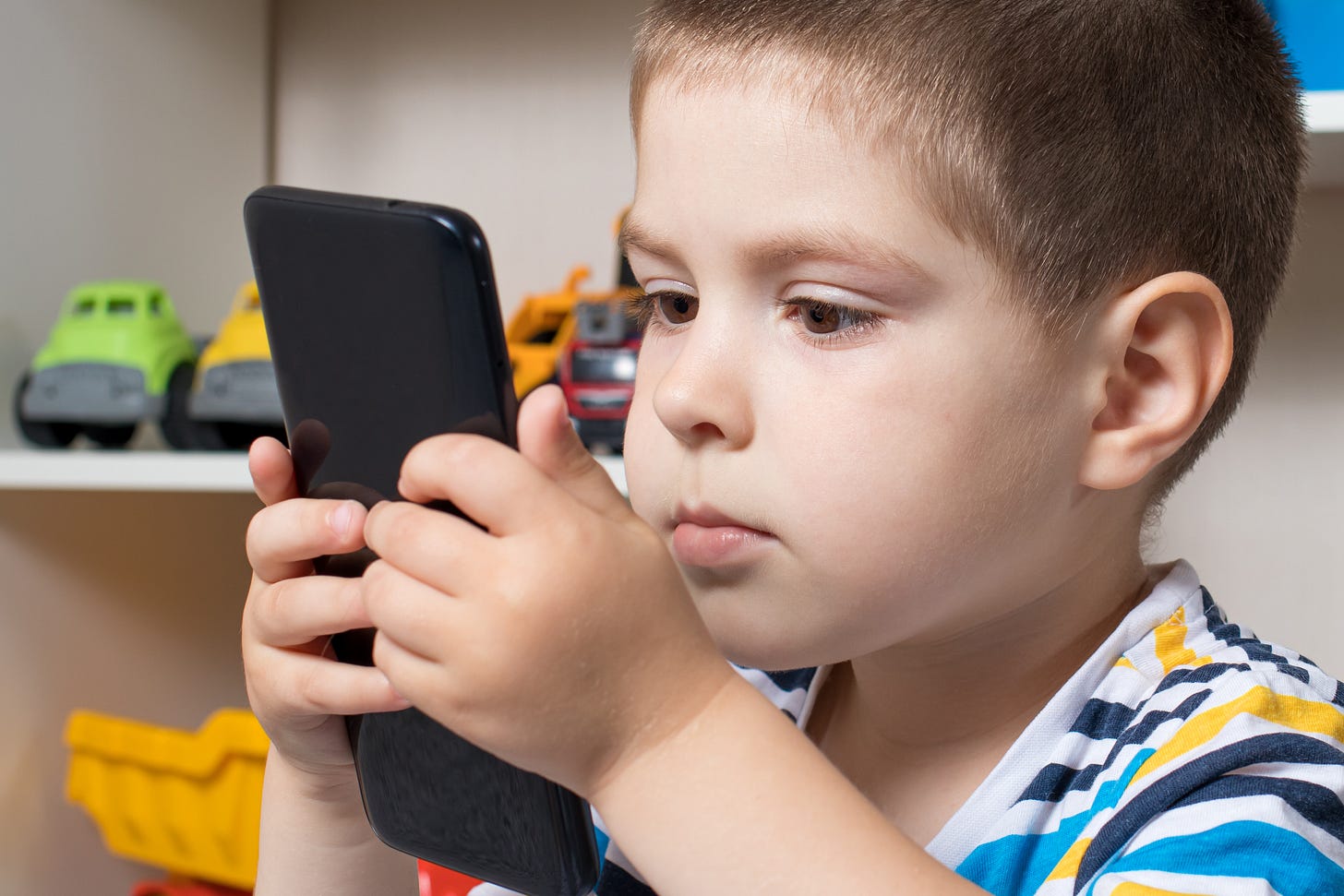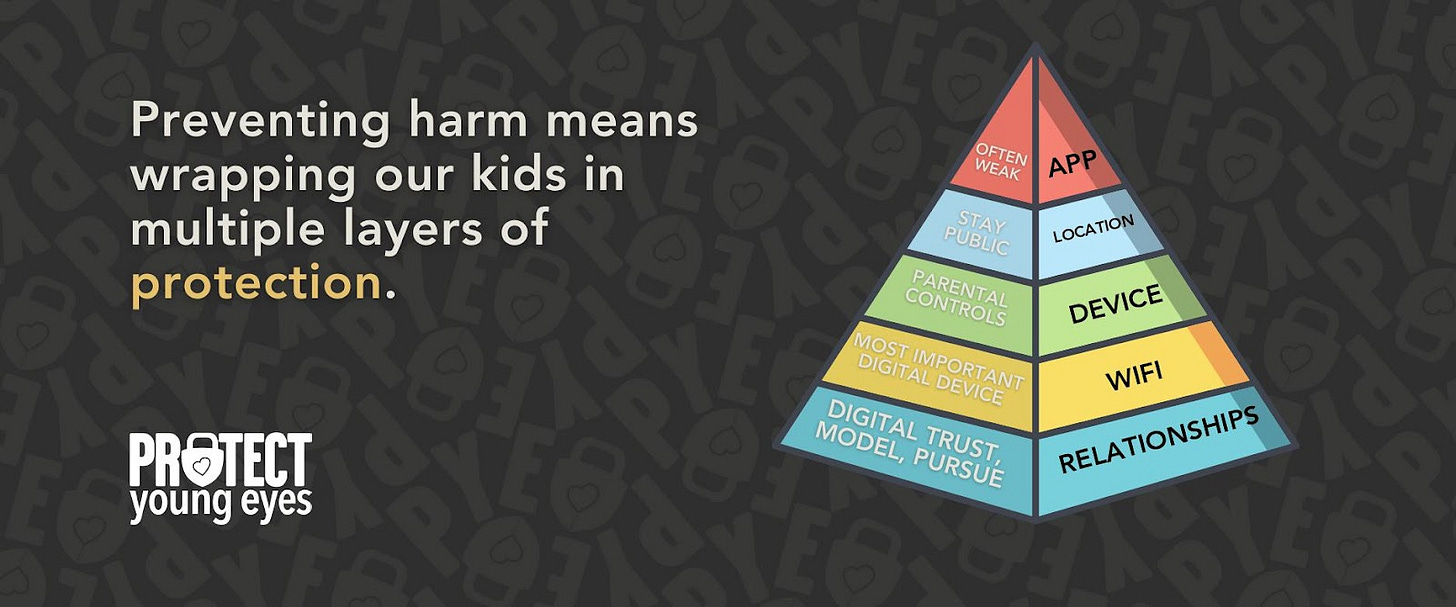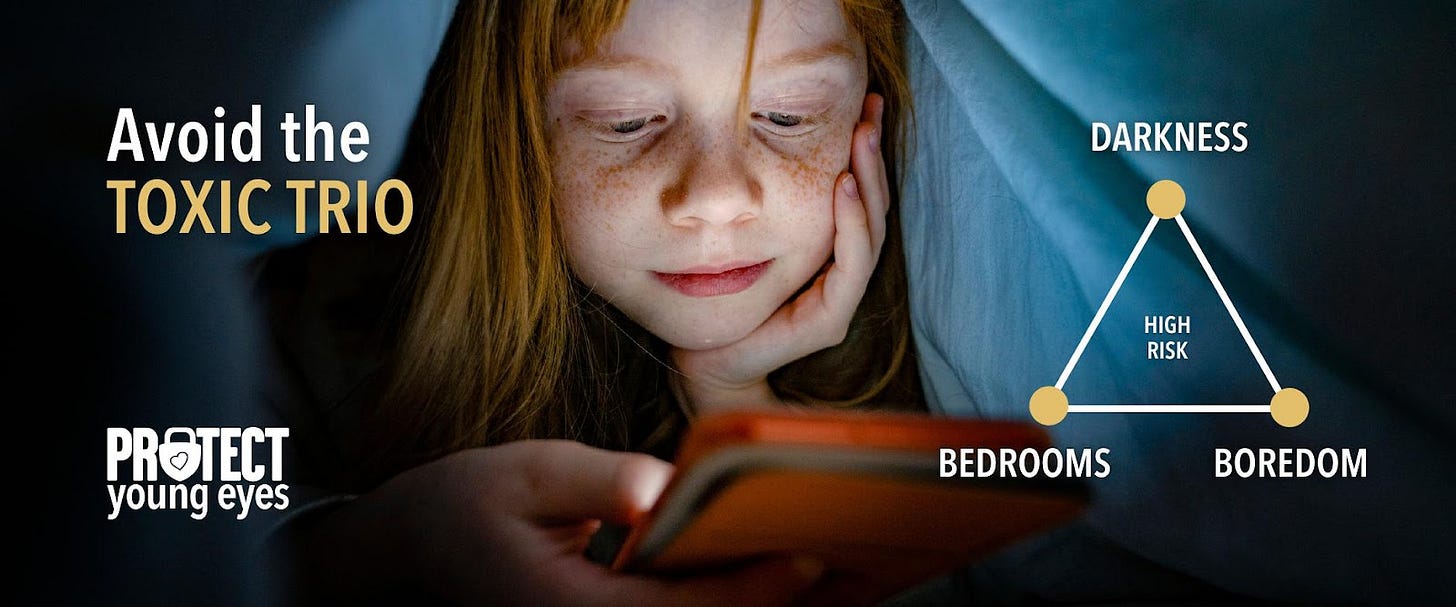How to Protect Kids from Porn
5 Layers that Prepare Our Kids for a Mature Digital World
Intro from Zach Rausch:
When I was eleven years old, back in 2006, a friend giddily showed me a website he had found on his computer. It was titled “XNXX.” I was nervous for us to lie and say we were 18 (would we get in trouble?) to enter the site, but he did not seem worried. I still remember the dark blue background, and the endless supply of hardcore porn meant for adults. This was the first time I had seen a naked woman, let alone adults having sex. We quickly closed the site when we heard his mom come up the stairs toward the bedroom. From that day forward, when I was alone by a computer, the thought would pop into my mind: XNXX?
Now, in 2025, eleven-year-olds no longer need a laptop or desktop computer. They can access the same kind of content, even more extreme and plentiful, by pulling a phone out of their pockets. They can now access it anytime, anywhere — in the bedroom, bathroom, classroom, or backseat of the car. Nineteen years later, and they still just need to click that button to say that they are 18. The availability and accessibility of hardcore online pornography (often violent, degrading, and addictive) is unprecedented. The effects of watching hardcore online pornography on children’s social and sexual development is not well understood, especially for the many boys who watch it every day, year after year.
Today’s post comes from Chris McKenna, founder of Protect Young Eyes, an organization working with schools, churches, and legislators to create safer digital spaces. Chris offers practical, compassionate guidance for parents trying to raise kids in this digital world, where it is to be expected that eleven-year-olds have come across pornographic images and videos. But Chris shows that there are ways to reduce the likelihood and the frequency for your own children.
– Zach
How to Protect Kids from Porn
By Chris McKenna
I recently received the following Instagram message from a mother who follows my work at Protect Young Eyes:
“I just caught my 11-year-old at 2 am looking at Pornhub. I’m totally heartbroken and don’t know how to recover from this. I have been crying for an hour trying to figure out what I did wrong. Where did I fail him? Is there a way to block incognito mode [on an iPad]? This is what he used, and it breaks my heart to think how many times this has happened. I don’t think I can sleep at all thinking about this.”
I wish messages like this were uncommon. Sadly, iPhones and iPads have backdoors to porn everywhere. This is a problem since over 87% of American teens have one. Even if you’ve activated Screen Time (Apple’s “controls” — quotes used intentionally because they suck), toggled off Apple’s Safari browser, and checked “limit adult websites,” which is supposed to activate a content filter, I can still see porn through a hidden browser in the Bible App.
Although difficult to measure, one study estimated that 27% of online video traffic is pornographic. To use an analog illustration, imagine four magazines on the coffee table in your living room every morning when you were growing up. One of them was pornographic, and three of them weren’t. And your parents just hoped you didn’t pick up the porn magazine. That’s what it’s like giving our kids access to anything digital and unfiltered today. Because as the song goes, “The Internet is for porn.”
To illustrate this point further: In 2024 alone, there were a total of 1,659,051 videos uploaded to PornHub. The site boasted over 13.5 million videos by the year 2020, including thousands of videos of illegally filmed minors.A recent After Babel piece from Freya India reminds us, “Modern porn is unlike anything else in history.”
My own story includes an early childhood exposure to pornography that warped my curiosities and was exacerbated by the internet. I created Protect Young Eyes to help as many families as possible prevent their 12-year-olds from stumbling into my experience. Porn is everywhere and its negative impacts on children are undeniable, but the right tools can help your families be prepared and protected.
Porn’s Negative Impacts on Young, Developing Minds
Although researching online pornography is difficult — since it’s unethical to randomly assign children to view (often violent) hardcore porn — a large body of evidence shows that exposure to today’s easily accessible, highly stimulating pornography poses significant risks to children’s social and emotional development.
A 2023 meta-analysis of five studies (3,846 adolescents) found a clear association (r = 0.39) between how often teens viewed porn and how realistic they believed it to be. Another 2023 meta-analysis of 27 studies (over 16,000 youth) found that children and adolescents exposed to sexual content (especially violent or live sexual content) had significantly higher odds of engaging in problematic sexual behaviors.
A 2019 study found that boys exposed to violent pornography were two to three times more likely to perpetrate teen dating violence than their peers who were not exposed. Boys who regularly view pornography are also more likely to exhibit aggressive behavior, both sexual and general, report substance use, and engage in risky sexual activity, such as having multiple partners at once.
For girls, one study found that female pornography viewers reported higher rates of depression and lower self-worth. Porn use has been linked to lower self-esteem in both boys and girls and may contribute to low relationship satisfaction.
Research from the Australian Government further highlights the problem, suggesting that pornography can reinforce attitudes supportive of sexual violence and violence against women.
Anecdotes from nurses, teachers, counselors, and parents alike report similar patterns: young children exposed to porn often suffer psychological distress that influences how they think, who they believe they are, and how they treat others in profound ways.
Freya India, who is 25, describes what it’s like growing up with porn as your generation’s primary sex-ed teacher:
“We learned the wrong things about love. We girls learned that sex is brutal, that men are predatory and insatiable, that the only way to be loved is to become a better object.”
It’s time to take this seriously. If we want our children to find love someday and to take pleasure in intimate relationships, then they must not learn about sex from porn videos. And, if governments and regulatory agencies insist on doing little to nothing to age-gate the internet, then the entire responsibility for protection falls upon parents. What can we do?
Five Layers of Digital Protection
Let’s get the obvious out of the way. The easiest way to lower the probability your child encounters porn is to delay their entry into digital spaces where it exists. According to the 2023 Common Sense Media report, among teen boys ages 13-17 who regularly watch porn, 38% do so via social media — TikTok, Snapchat, Instagram, and Reddit.
Therefore, follow the norms in The Anxious Generation: No smartphones until high school and wait on social media until at least age 16. Because #delayistheway. But whether you’ve said “no,” “slow,” or “go” with technology, wrapping our kids in layers of protection decreases the likelihood of a problem with pornography.
Layer One: Build the Relationship
Talk about porn early. Probably two years before you want to. We say “10 before 10.” We want 10 porn talks before age 10. Make it a “normal” conversation and be the authority. Assure your kids they can land safely with you when they see it.
And after these essential conversations, practice, practice, practice. Make it rote and concrete. Their brains need this. For young kids, sit them at the table with an iPad and tell them you’re going to your room with the door closed. When you yell “ready,” you want them to turn the tablet over, come up the stairs, and tell you, “Mom, I saw something on the tablet that makes me uncomfortable. Can I talk to you?”
With older teens, filters are still appropriate but lean heavily on relational tactics. This means talking about everything with brutal honesty. Remind them that pornography is not the standard for real-life sex. And for these key messages, say them often. If they’re not rolling their eyes and finishing your sentences, you’re not saying it enough.
Digital drops. Little bits, over time. When talking to our children, there’s no need for elaborate presentations. You don’t have to be perfect, elegant, deep, or articulate. Instead, aim for consistent, quick, curious, and caring. Maybe use a book to guide the discussion (our recommendations).
“Constant water hollows out a stone.” — Lucretius (Roman poet)
If you discover they’re looking at porn, respond with calm and candor. That’s how you build what we call Digital Trust. We have a whole guide for “What to Do When Your Child Is Looking at Porn.” And it starts with the very best way to build Digital Trust: “Don’t freak out, don’t freak out, don’t freak out.” Or, they’ll never come back to you when it happens again.
Don’t underestimate the power of layer one — relationships. There aren’t enough toggles, controls, and software to compensate for a lack of authentic connection with your child.
Layer Two: Hug Your Router
When was the last time you thought about your router? Go ahead — list everything in your home that uses your WiFi, because it’s often a long list. I realize smartphones and some tablets have data plans. We’ll cover those in a moment. But first, it’s time to hug your router because it’s the most important digital device in your home when it comes to preventing problems with porn.
Consider this story:
“Our son was secretly given a trap (burner) phone by a friend and used it to access pornography and social media. Our daughter borrowed a school-issued device and quietly kept it, watching YouTube late into the night. We might have caught both sooner had we been checking for unknown devices on our home Wi-Fi. I share this not to discourage, but to prepare: even committed families face workarounds.”
Both of these situations are preventable with the right router. Because routers help families with both control and culture.
Control, because your router allows an internet signal to “enter” your home, like your front door. And like a lock on that front door, a router with a filter, time controls, VPN blockers, and other monitoring features can prevent harm from entering your home.
Remember, young children most often use WiFi-only devices. Think Chromebooks, tablets, SmartTVs, MacBooks, and gaming consoles. This means they depend on your router to connect to the internet. A good router can lock in SafeSearch, and YouTube Restricted mode, block pop-ups, and prevent access to harmful sites. A good router can prevent an accidental, early-childhood exposure to pornography.
Culture, because a good router lets everyone know it’s important to block porn on your home internet. If you’re not sure how to set up a new router, ask your child to help you! And during that time, explain what a router does and why you’re using one with stronger controls. It also sets you up for a conversation about burner phones and “secret” devices, like the story above. And burner phones are everywhere. That old iPhone 12? It’s now just like an old iPod, waiting to connect to the internet. And like the note above, kids at the schools we visit report easy access to old Apple devices through their friends.
In my home, if a new device attempts to use our WiFi, even if the person knows the password, I receive a notification, and they’re blocked until I let them in through my router’s app on my phone. This is because every internet-connected device has a unique MAC ID, and my router is set to block those it hasn’t seen before.
Don’t worry. If the word “router” increases your stress level, you might benefit from our most popular post with parents, The Ultimate Guide to Understanding Routers.
Layer Three: Monitor Every Device
For all devices in our homes, we use controls that come with the device (at the account or operating system level) and/or by using third-party software.
“But Chris, didn’t we just talk about filtering in the WiFi layer?” Yes, but smartphones have data, and even WiFi devices, like Chromebooks, travel to homes where they might not have a strong router in place. So, like a “belt and suspenders,” we filter porn in the WiFi layer and on the device itself.
That’s why we activate whatever we can on all devices, including parent devices (I have endless emails from parents and grandparents whose children and grandchildren got to porn on their adult device). We also only give kids access to devices they’re developmentally ready to be using. Globally, the selection of kid-friendly phones and watches is growing, as explained in our Global Catalogue of First Phone Options.
By the way, if you’re wondering, no third-party software solutions monitor Snapchat, Instagram, or TikTok on iPhones. This is because Apple won’t let them.
Special note about school-issued devices, like Chromebooks. Be very skeptical. Ensure you understand what the school is and isn’t monitoring. It’s often less than you think.
Layer Four: Guard the Location
Where kids use technology has a massive impact on how they use technology.
An informal survey of 150 high school students at a school where we worked found the following:
61% consumed pornography when they were in their bedrooms.
48% identified boredom as how they felt just before watching porn
This means we avoid using technology in five places that increase the risk of digital harm: bathrooms, bedrooms, buses, sleepovers, and grandma and grandpa’s house. So in all cases, we avoid the toxic trio, which is bedrooms, boredom, and darkness, combined with anything online.
Remember: whether you’re age 4, 14, or 40, technology is always better when it’s a “we” activity, and not just a “me” activity, used in the light.
Layer Five: App Controls Are Weak. Use Them Anyway.
Popular apps like YouTube, Snapchat, TikTok, and Instagram have some parental controls. But they’re at the top of the pyramid because we depend on them the least. Why? Because app community guidelines likely don’t support your family’s values.
Use the PYE 7-day rule. I don’t care what cartoon character is on the app logo; you download the app and use it for seven straight days, regularly, and with a child’s account, so you can see what your child might see. What ads are in the game? Did you know iPhone games rated 4+ have ads for mature apps rated 12+? What language is used? Is there a chat feature (which is very common)?
Ask yourself, “Do I want my child to experience everything I’ve experienced?”
Make It a Sign
I don’t have a technology degree. And I’m guessing many of you reading this don’t either. But that isn’t necessary for you to be successful. I believe every parent and caregiver has digital superpowers just waiting to be unleashed! Practice by doing simple, practical things consistently and persistently, and although I can’t promise you’ll never have a porn problem, you will decrease the chance that it harms your family.
Here’s a simple, practical step. A woman who attended one of our parent presentations typed up keywords from her notes on a sign and put it in their tech drawer, where kids plug in at night. She believes it’s one of the most important teaching tools in her home (download an editable version here!). Just a simple sign.
At Protect Young Eyes, we will continue applying pressure on the industry and policymakers. And we’re seeing positive changes. But it’s up to amazing parents and caregivers like you to do practical things over and over to prepare and protect your kids online. Step-by-step, chat-by-chat, I hope this post encourages you.







These are all great tips, but the BETTER solution is to for Congress to mandate that all pornography be available only via a PAID subscription. That would cut out 90+% of all adult pornography viewing and probably 99% of child pornography viewing. Why are we as parents and adults not demanding this??
The method we used to help monitor internet access started with the router. Only recognized MAC addresses were allowed to access and use the bandwidth provided. Phones are just part of the deluge of devices available. Add into the mix WIFI enabled vibration devices and now you get a sense of what is out there.
The other rules and methods used were to review the phone/laptop usage at the end of each day, have access to all app passwords, and lock down the phone/laptop so the “user” had no administrator privileges (unable to install software or apps). Phones and laptops were not allowed to be used after 8:00 PM, left on the kitchen table at night, and homework was to be done prior to the 8:00 PM lockdown. Plus, to further dampen the workarounds, browser history collected and stored in an administrator accessible location, and a packet sniffer was deployed targeting the MAC addresses of the controlled devices. That way all was laid bare.
It may sound draconian, but this is what was used. I simply stated “All social apps, your employer, every other app you use, open WIFI locations, including everyone else on the public WIFI service you’re connected to collect and store this data, so why can’t I?” Most reading this will think it’s too much heavy lifting to implement, but that’s what it takes.